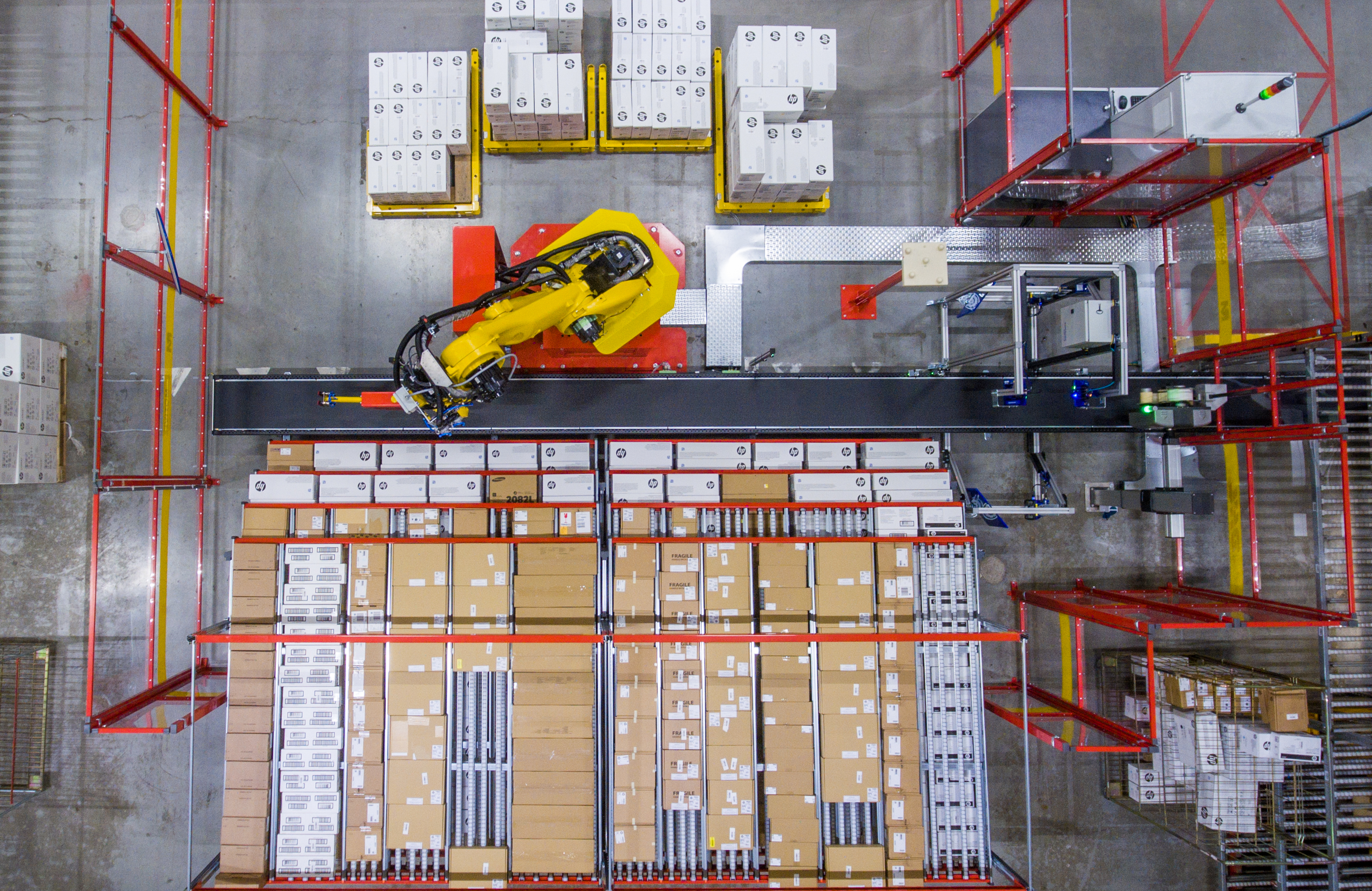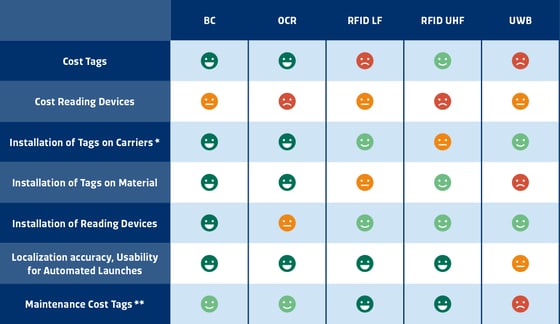
In a post-pandemic world, the demand for consumer spending has drastically increased. According to the most recent 2020 ARTS release, e-commerce sales increased by $244.2 billion or 43% in 2020, the first year of the pandemic, rising from $571.2 billion in 2019 to $815.4 billion in 2020 in the US alone. Now more than ever, manufacturers and e-commerce businesses need to improve their productivity with an automated material handling process.
In this extensive article, we will look at the definition of “material handling”, how to automate your material handling application and what are the benefits of it. We will then see why machine vision is an essential component of this robotic application and finally give some examples of successful automated solutions using 3D machine vision.
Table of contents
Dictionary.com explains material handling as “the loading, unloading, and movement of goods, as within a factory or warehouse, especially by the aid of mechanical devices.” It is a good start, but it is a bit more than just taking care of an inventory. It’s the movement, protection, storage, and control of materials and products throughout their lifespan of manufacturing, warehousing, distribution, consumption, and disposal. In a logistics environment, material handling is basically the conduct of a given product flow from start to end.
Here is an example of a typical product flow illustrated by REB Storage Systems International:

This type of task necessitates maximum efficiency. First, to avoid delays and satisfy the customer, but also to react and plan in time for any warehouse requirements. It can be tricky, especially on a large scale. That is when material handling becomes an essential component of any successful warehouse. It can improve customer service by making products easy to find, move, and ship out. It also makes your working people’s life so much easier as it improves the smoothness of your facility. To succeed, logistics professionals rely on a variety of systems (single-level storage, multi-level storage, conveyors, etc.) and equipment types (manual, semi-automated, and automated).
As the demand in logistics is constantly increasing (and even more after the Pandemic), more and more companies are turning to automated equipment. Over the past two years, we’ve seen an explosion in demand through e-commerce and an expectation of continued growth through 2025. “Automation” used to be a scary word, one that implied unemployed assembly line workers and robotic takeovers. But these days, thanks to ever-advancing technology, automation is getting more and more mainstream. The shortage of low-skilled labor has pushed manufacturers to invest in automation, and humans to reskill and/or upskill. ABI Research state that 452,000 robots will ship in 2022, a massive increase of 65% compared to 2021.
Automating the process shows many benefits that can bring your material handling solution to the next level.
You can find many more benefits to automating your logistics system depending on your own configuration and situation. What are the features of an automated material handling system (AMHS)?

3D machine vision is being more and more applied to a broad spectrum of tasks where 2D capability falls short like quality control, detection of surface and assembly defects, object scanning, etc. As an example in logistics, DHL has developed a fully automated e-commerce order picking robot cell using 3D vision. The tasks of depalletizing, picking and order fulfillment in traditional e-commerce warehouses have traditionally been handled by human operators. The work though is highly repetitive, physically strenuous, and prone to the risk of human error. Automation of such high-volume processes not only increases throughput and accuracy but also enables logistics firms to reassign human operators to concentrate on safer, more complex tasks, where they add more value to warehouse operations.
The 3D camera in DHL’s system is an integral part of a complete turnkey solution, enabling the robot to see the boxes clearly and sort them out, making depalletizing, picking and order-fulfillment easy. It would have been much more difficult to operate these tasks with a 2D sensor as a box has a three-dimensional shape.
Here are some 3D point cloud examples of some typical items handled in logistics, using Zivid’s technology:
To make your material handling vision system function properly, it is necessary to calibrate your 3D camera. Hand-eye calibration is the binding process between the vision component (camera) and a robot. To help developers understand and get started with designing a robust vision-guided robot system for the logistics industry, we created this e-book about hand-eye calibration:
.png?width=500&name=Free%20eBook%20(1080%20%C3%97%20900px).png)
As you understand more about how hand-eye calibration works, you will learn more about how to run your automation system more precisely and efficiently.
Fizyr are experts in pick and place solutions for the logistics industry with a solid understanding of the challenges involved. Together with Zivid 3D camera technology they have developed, and deployed systems that are operating at some of the biggest logistics facilities on the planet. This is all about recognition, making a decision, and acting correctly on that decision. Fizyr excel at software that can perform this task. But the data in any system will determine its efficacy. That is why they use Zivid 3D vision for robots with their unparalleled point cloud fidelity in color. They are able to depend on what the robot is seeing and make informed decisions about automated picking and sorting.
Read the case study →
Through the robotization of its warehouses, global logistics leader DHL is increasing both the efficiency of its e-commerce operations and the satisfaction of its employees at the same time. For a labor-intensive depalletizing, picking, and fulfillment operation, DHL turned to system integrator Robomotive for a flexible solution able to cope with a highly dynamic business environment. The Zivid One 3D color camera played a key role in an advanced robot cell design.
Read the case study →
Environmental legislation is driving a move towards low emission electrical propulsion for ferries and other vessels. With its new factory in Trondheim, Norway, Siemens is addressing the rapidly growing demand for maritime batteries. In a highly automated production line engineered by system integrator Intek, Zivid’s 3D machine vision camera played a vital role in optimizing production efficiency.
Read the case study →
Material handling is the movement, protection, storage, and control of materials and products throughout their lifespan of manufacturing, warehousing, distribution, consumption, and disposal. Through this article and several examples, we have seen the number of automated logistics systems is increasing all around the world to answer to the rapid growth of consumer spending.
If the benefits of a AMHS are undoubted, the components of the actual system can vary depending on the nature of your business. You must figure out by yourself what equipment, software, and vision hardware you need to put together to maximize your chances of a successful system.
3D in logistics has so many advantages for logistics applications: your robotic system has the best eyes it can get. To help developers get started with designing a robust 3D vision-guided robot system for the logistics industry, we created this technical e-book about calibration. As you understand more about how hand-eye calibration works, you will learn more about how to make run your automation system more precisely and efficiently.
These Stories on Logistics



Zivid brings
Gjerdrums
N-0484, Oslo
Norway
No Comments Yet
Let us know what you think